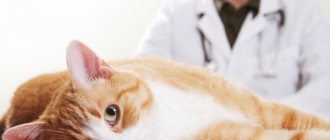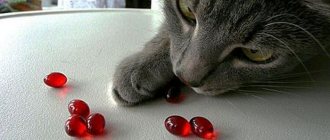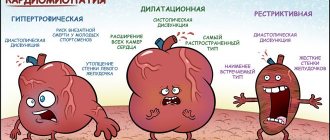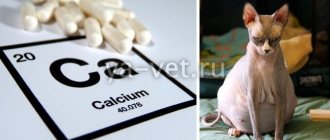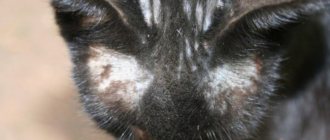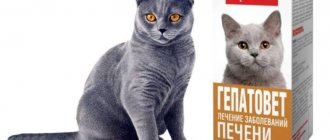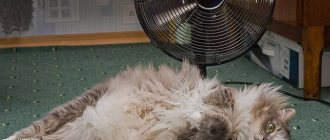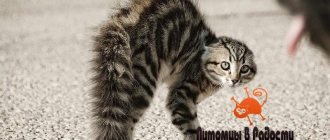3866Pavel
Feline hepatic lipidosis is a large amount of accumulated fat in the liver. It is a popular and dangerous liver disease in felines. Liver lipidosis in cats becomes noticeable when an excessive amount of triglycerides accumulates in hepatocytes in an amount of more than half. This can lead to interruptions in liver function and severe cholestasis.
The disease lipidosis occurs due to severe or constant starvation of cats. Without treatment, developing metabolic dysregulation often occurs, and subsequently death. The liver is considered the most important organ in the body and performs a large number of different functions, including metabolism, emulsification of fats and breakdown of red blood cells. Due to this, a malfunction of the liver, which occurs when lipids accumulate, can cause death in cats due to liver failure.
© shutterstock
There are two types of lipidosis::
- primary – this type appears in cats with obesity or anorexia. Without proper treatment, lipidosis is fatal.
- secondary – this type of disease appears as a complication after other diseases. Therefore, the cat needs intensive immediate treatment for lipidosis, along with the underlying disease.
The risk group includes cats and mature cats living in houses. Cats living with humans are predisposed to becoming overweight due to a sedentary life and due to improper feeding. Cats are carnivorous animals, members of the cat family. In the wild, they can hunt and lead an active life, and due to this, reduce the accumulation of excess fat throughout the body to zero. The owner needs to closely monitor the pet so as not to miss the symptoms of liver lipidosis in cats.
The cat's body is not able to convert a large amount of accumulated fat deposits, because of this, the fat that appears in the liver is poorly processed. This creates the prerequisites for changes in lipid metabolism, the accumulation of fat in the liver and the formation of its dysfunction, and as a result, liver lipidosis syndrome may appear in cats.
© shutterstock
Causes
Fatty liver is associated with various causes. It often develops against the background of infectious diseases, toxin poisoning, and oncology.
In recent years, veterinarians are increasingly diagnosing lipidosis in animals that were previously diagnosed with:
- diabetes;
- heart pathologies;
- renal failure;
- urogenital pathologies;
- hyperthyroidism;
- vitamin deficiency, especially B12 deficiency;
- pathologies of the respiratory system;
- pancreatitis;
- diseases of the neurological group;
- autoimmune disorders.
In every second case, it is not possible to establish the exact cause, so in half of the cats the diagnosis is “idiopathic lipidosis.”
What is lipidosis
Any cat that is overweight is at risk. Owners of animals who are stressed due to a sudden change in food or who have some other illness should also be wary.
The disease is characterized by the proliferation of adipose tissue in hepatocytes. Due to the degeneration of organ cells into fatty liver, it becomes like a piece of lard. If too many fatty acids are supplied, the organ cells cannot cope with their processing.
Many veterinarians have recently associated the appearance of the disease with hyperthyroidism, pathologies of the heart, kidneys, diabetes and other factors. But in less than half of the cases, tailed patients are diagnosed with “idiopathic lipidosis”, since the doctor cannot determine the cause of the disease.
Two independent forms of pathology are known:
- Primary can manifest itself in an overweight or anorexic animal. If the disease is not diagnosed in time and assistance is not provided, the pet will die.
- Secondary always appears against the background of an underlying disease - diabetes, pancreatitis, heart disease, or others. A specialist has to treat both diseases.
Risk group
The main risk group consists of mature individuals, regardless of gender, kept in apartments without free range. Cats that permanently live with humans lead a sedentary lifestyle and often overeat. In their natural environment, they are forced to hunt to feed themselves. Activity prevents fat from accumulating.
Cats that are under stress for a long time also have a risk of developing pathology. The cause of stress can be a change of environment, the appearance of another animal in the apartment, changes in the usual diet, or lengthy renovations.
Lipidosis in cats can develop against the background of another disease, so during its treatment it is important for owners to pay attention to symptoms characteristic of liver damage and any changes in the pet’s behavior.
General characteristics of idiopathic liver lipidosis in cats
IHL occurs in adult cats of both sexes and any breed. One of the main principles of successful treatment of IHL is its early diagnosis. Fortunately, some risk factors for IHL are easily recognized and should be of concern to pet owners and clinicians. The onset of IHL is almost always preceded by obesity. Despite the fact that stress is a more subjective symptom, it plays an important role in the “stimulation” of this syndrome. Typical examples of stress are changes in diet and feeding the animal less favorite foods, which leads to a reduction in food intake; change of situation; infection resulting from a bite wound. Clinical signs include decreased appetite or increased pickiness in feeding, which can lead to complete anorexia in a few days to a few weeks. Significant weight loss (>25% of normal body weight) and loss of muscle mass are often observed, but this may not be noticeable due to ongoing obesity. Cats typically have mild to moderate depression. Sporadic vomiting often occurs. You may not notice the gradually developing jaundice and recognize it already in a clearly expressed form. Hepatomegaly is common, but usually mild. As the disease progresses, signs of severe liver dysfunction appear, such as hepatic encephalopathy (ptialism, depression, stupor) and coagulation disorders; these symptoms indicate the presence of severe complications. In liver failure, the prognosis is guarded or unfavorable.
Typical laboratory abnormalities indicate the presence of cholestatic liver disease, and as the disease progresses, biochemical pathological changes characteristic of liver failure appear. Serum alkaline phosphatase (ALP) activity is often markedly elevated, but, surprisingly, gamma-glutamyltransferase activity is normal or only slightly elevated (Center et al., 1993). Alkaline aminotransferase (ALT) and aspartate aminotransferase activities are slightly to moderately elevated in many cases, but usually not as much as ALP. Other signs of cholestasis and liver dysfunction are hyperbilirubinemia, bilirubinuria, and increased serum bile acids. Hypoglycemia, hypoalbuminemia, hyperammonemia, and coagulation disorders are also associated with severe liver dysfunction. Abdominal radiography in cats with uncomplicated IHL usually shows only mild hepatomegaly. Ultrasound examination of the liver with lipidosis is characterized by generalized hyperechogenicity. In addition, abdominal ultrasound helps to exclude extrahepatic biliary obstruction, since IHL and pancreatitis are characterized by normal sizes of extrahepatic bile ducts (data on peritoneal effusion and characteristic mixed echogenic neoplasms in the pancreas are not available). An accurate diagnosis is best made by liver biopsy (percutaneous needle biopsy or wedge biopsy taken during laparotomy). Cytologic examination of liver material obtained by percutaneous fine-needle aspiration provides a presumptive diagnosis of HL, and this procedure is usually safer for the patient than open biopsy under general anesthesia and surgery.
Symptoms
The first thing that catches your eye is the sickly appearance of the animal. The cat is aging quickly, deteriorating before our eyes, and losing weight. The fur becomes dull, breaks in places, and the condition of the skin worsens.
It is important! Owners of long-haired breeds need to be especially careful. Behind the dense coat, a sharp loss of weight is not immediately noticeable, but when palpating, your fingers will clearly feel the vertebrae and protruding ribs.
You can suspect liver lipidosis in cats based on other symptoms:
- Lack of appetite for 10-14 days.
- A state close to lethargy.
- Vomiting, bowel movements.
- Lethargy.
- Depressed state.
- Increased salivation.
Even one of the listed symptoms is a serious cause for concern. You should immediately contact a veterinary clinic if your pet has lost more than ¼ of its body weight in a matter of days or freezes for some time without reason.
At the initial stage, characteristic signs may not appear - the disease progresses gradually. Subsequently, cats develop symptoms of jaundice - the whites of the eyes acquire a yellow tint, and a yellow coating appears on the tissues in the oral cavity.
This condition indicates severe liver damage and is often accompanied by increased salivation and bleeding disorders.
Attention! The chances of a complete recovery without serious disorders in the animal’s body are high if the disease is recognized in a timely manner and qualified treatment is prescribed. The liver is a special organ; its cells and tissues are capable of self-healing and renewal.
Etiology
We have already received a general idea of what diffuse hepatic steatosis is, and now it’s time to move on to the details. The cause of disturbances in phospholipid metabolism and the resulting increase in the level of free fatty acids in the liver parenchyma is usually an incorrect lifestyle and diet in particular.
We can say that steatosis is a disease of lazy people.
Obesity greatly contributes to the accumulation of lipids in liver tissue. Add to this the bad environment, and we get a portrait of a typical patient with fatty liver: not too young, not too slim and predisposed to alcohol. The list of predisposing factors looks something like this:
- drug addiction (morphine derivatives, methamphetamine, any potent psychotropic substances).
- alcohol abuse;
- pharmacological drugs that have hepatotoxic side effects (anti-inflammatory, hormonal, painkillers, antibiotics and antidepressants);
- congenital metabolic disorder (malabsorption syndrome);
- impaired absorption of protein and vitamins due to previous operations (for example, resection of the small intestine);
- chronic diseases of the gastrointestinal tract, in which the absorption of nutrients worsens (most often colitis, pancreatitis);
- insufficient amount of protein in the diet (protein contributes to the normal absorption of fats);
- chronic foci of infection in the body, severe intestinal dysbiosis, accompanied by general intoxication of the body;
- diabetes;
- general obesity;
We suggest you read: Epiphora in cats: general information, causes and treatment
At first glance, the issue is not as acute as, for example, alcohol or drug abuse. However, this is precisely why nutritional issues are often not given enough attention, which provokes fatty liver degeneration. Vegetarians (and especially vegans - the most radical representatives of the movement) deprive themselves of animal protein, which helps the normal absorption of fat.
The lack of animal protein food can somehow be compensated for by cottage cheese, milk and cheese, but vegans do not accept even such a diet, so they chronically do not receive enough amino acids. At the same time, as compensation, they often indulge in sweet dishes, which also has a bad effect on the condition of the liver.
Alcohol occupies a special niche among the factors contributing to the development of the disease. Most cases of fatty liver degeneration are precisely the result of abuse of ethanol derivatives. Alcoholic steatosis of the liver often ends in cirrhosis - irreversible changes in liver tissue.
That is why even a special abbreviation NAFLD arose - liver steatosis not caused by alcohol consumption (literally: Non-alcoholic Fatty Liver Disease).
Diagnostics
Diagnosis of liver lipidosis is carried out in a clinical setting. The veterinarian listens to the owners’ complaints, examines the cat, and prescribes a set of laboratory and instrumental studies:
- general blood analysis;
- general urine analysis;
- blood chemistry;
- aminotransferases AST and ALT;
- bilirubin.
The results of the studies allow us to assess the functionality of the liver. To visualize the lesions, ultrasound or x-rays are prescribed. These studies give an idea of the structural changes in the organ and the severity of the changes that have occurred.
A biopsy allows you to determine the pathology with 100% accuracy. The cat is given anesthesia and a small piece of the organ is taken for examination. The sampling is made with an aspiration needle. Then the material is examined under a microscope, the contents of the cells are determined and an accurate diagnosis is made. With a progressive disease, there will be fat in place of normal cells.
Attention! When collecting material, there is a risk of internal bleeding, because perforation of a large blood vessel with a needle cannot be ruled out. To prevent consequences, the animal is given vitamin K 12 hours before the biopsy.
About the role of the liver in the body
Articles about diseases often begin like this: this “organ” is the most important in the body. This material also deserves such a beginning, since an animal cannot live without a liver, just as without kidneys, brain or heart. The liver is considered a secondary organ, but only in human medicine and only because its transplantation no longer causes horror and delight. In veterinary medicine, due attention is paid to the health of each organ, since if “one” fails, all will die.
The functions of the liver are diverse. First of all, it is a filter that purifies the blood . The liver doesn't just filter the blood, it removes toxins from it and breaks them down. The liver is usually considered in conjunction with the gallbladder. Bile is a caustic liquid involved in digestion. More specifically, bile helps the intestines digest fatty foods. The more fatty foods a cat eats, the more bile will be released into the intestines.
Liver diseases can develop either independently or as a consequence of some disorder. Excess weight leads to fatty liver and disruption of its functions. When poisoned, the liver is worn out and can be damaged to an irreversible state. At the same time, there is such a thing as hepatitis - inflammation of the liver and viral hepatitis - also inflammation, but provoked by infection of the animal. The gallbladder can also suffer from a number of pathologies, for example, stones can form in it and the ducts.
Unfortunately, most liver diseases develop due to :
- Improper feeding - a diet oversaturated with fats or carbohydrates.
- Incorrect treatment - owners often treat their charges at random. For example, aspirin and paracetamol, which are commonly used to reduce fever, are very toxic to cats. Some human sedatives and heart medications literally destroy animal liver cells. Even many veterinary drugs, for example those used to treat parasites, place a very serious burden on the liver and must be strictly dosed.
- Excess weight - the cat should not be fat. If your pet is covered in fatty tissue, he is not cute, he is sick!
- Parasites - liver flukes feed on blood and liver cells. A cat becomes infected with these worms by consuming raw seafood. It is difficult to remove such parasites, and it is almost impossible to diagnose them at an early stage of infestation.
Below we look at the most common liver diseases. If you suspect that your pet is sick, consult a doctor. Self-medication when the liver is already affected is not only dangerous...it can lead to the death of your pet.
Treatment
Treatment of lipidosis in cats is carried out in a hospital or outpatient setting. A hospital stay is indicated if the disease is severe, with complications, or during surgical intervention.
Outpatient therapy is prescribed for animals experiencing severe stress. It is easier to overcome it in familiar home conditions, but this must be done for medical reasons, since stress aggravates the course of the disease.
During the treatment process, it is important to restore normal nutrition to the pets. For this purpose, special industrial feeds are used. If food disgusts the cat, a tube is installed through which liquid food is slowly introduced. Sometimes tube feeding lasts a month or more until the animal begins to feed on its own.
Feeding a cat through a tube
Cats with fatty degeneration are prescribed IVs to maintain and restore water balance in the body. Their composition is prescribed by the doctor, focusing on the results of laboratory tests.
Therapy also includes taking antiemetic drugs, and in case of severe liver damage, vitamins. Vitamins are required, because due to problems with the organ, hypovitaminosis develops in cats and complicates the course of the disease.
The veterinarian prescribes medications, dosage, and duration of use individually. He may prescribe antibiotics to animals with weakened immune systems to prevent complications and the development of infectious diseases.
Nutritional Features
If the animal can eat on its own, then it needs to be given special food that will support its strength.
Kusenkova Natalia Yurievna, a veterinary endocrinologist, believes that a prerequisite for treating liver lipidosis in a cat, in addition to medications, is regular feeding. If the appetite is maintained, the veterinarian selects medicinal food that ensures saturation and the supply of the required amount of vitamins. In cases of lack of interest in food and severe disease, feeding tubes are used to forcefully administer food. The main methods of feeding a cat are described in the table:
| Name | Installation | Advantages | Flaws |
| Nasogastric tube | Through the nasal cavity into the stomach | Ease of installation | The need to wear a collar for fixation |
| Ease of use | Possibility of introducing only liquid food | ||
| No anesthesia required | Short lifespan | ||
| Esophagostomy | Through an incision in the neck into the esophagus | Introduction of liquid and crushed food | Anesthesia required for installation |
| Convenient due to larger tube diameter | |||
| Gastrostomy (gastric tube) | Through the abdominal cavity into the stomach | Protection with a special bandage | |
| Ease of use | |||
| Long-term use |
Forecasts
If pathology is detected at an early stage and treated in a timely manner, the prognosis is favorable. Severe lipidosis is fatal in 30% of cases, even if the animal has received intensive care.
The recovery period is long, taking 1.5-2 months - the owners will have to keep the pet on a strict diet all this time and feed it through a tube or intravenously.
Feeding a cat through an esophageal tube
Like any disease, lipidosis is easier to prevent than to cure. For prevention purposes, the diet of cats should be balanced and of high quality. Cheap or expired food is prohibited.
The food should have a sufficient amount of protein, but it should not be high in calories. Owners need to ensure that their pet does not become obese. If he refuses food for 2 days, you need to urgently contact a veterinary clinic.
Disease prevention
There is no unambiguous preventive regimen that can completely protect a cat from a disease such as lipidosis. Its development is impossible, if only because in most of the recorded cases, doctors are not able to establish the exact pathogenesis that provoked the development of the disease. However, experts offer caring owners advice that will significantly reduce the risk of pathology in the cat’s body. These include:
- a balanced menu rich in vitamins and minerals. Dilute your cat’s diet with vegetables and fruits; the fiber they contain promotes the digestion process;
- try to feed the animal in portions, form the portions themselves based on its size, this will protect your pet from oversaturation;
- monitor the cat’s weight, at the first signs of obesity, take measures to eliminate obesity;
- provide your cat with timely vaccination and deworming;
- add nutritional supplements to your food that have a beneficial effect on liver function, for example, Hepatovet.
Finally, I would like to say that lipidosis is a dangerous disease that, in advanced forms, can lead to unpleasant and irreversible consequences for a pet. If the owner notices symptoms of this pathology in an animal, he should immediately take him for examination to a veterinarian. Only with a quick diagnosis and careful implementation of all medical recommendations by the cat’s owners, can the transformation of the liver into a piece of lard be quickly stopped, as well as minimize the damage from such harmful processes.
Who should not be held?
Diagnosis is not carried out in the presence of blood clotting disorders. Different types of biopsies are dangerous and prohibited for conditions such as:
- mental illness;
- acute inflammation;
- pathologies of the blood coagulation system;
- vein thrombosis;
- hemophilia;
- alveococcal cyst;
- obesity 3-4 degrees;
- inability to determine exactly the puncture site.
